Catchers 101
 |
| Eric Berg living it up at Target Field |
In a baseball game, all nine players on the field have a role. On any given play, every player has a different job, dictated by the ball in play and the situation before and after contact. Additionally, those responsibilities may change during the course of the play, if something like an error, bad hop or aggressive runner changes the circumstances.
Each player on the field is important to the success of the team. At the end of the game, the talk might be about the amazing diving stop the shortstop made. Or the homerun saving catch the centerfielder made. Or the strikeout the pitcher got to end the game.
All of these are great plays and deserve recognition and backslapping. They make the game exciting.
What you probably won't hear is how the catcher framed that last pitch so well it went from being a ball to a strike. Or how they sat in a squat position for 150 pitches. Or how they caught the last 4 innings after taking a foul ball right to the cup.
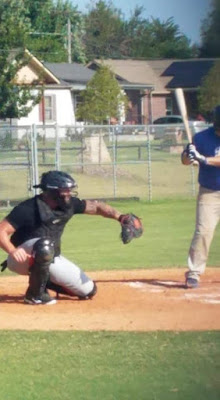 |
| Jeremy Nichols with the OKC Vipers |
The catcher may arguably be the most important position on the field. But they are often the least recognized, unless it's for their offense or making mistakes in a game. When a catcher does their job well, no one thinks twice about it.
And catchers are ok with that. It's part of the job. The personality. It's how they are made. If they want to hear about what others think of their play, it's because they want to get better behind the plate.
Catching isn't for everyone.
My Adult Catching Journey
When I joined the local adult baseball league, I came on as a shortstop. I'd played there in softball for the previous 8 years and developed into a solid 6 hole player. Coming back into baseball for the first time in over 20 years, I had some growing pains in the position, but solidified my place there.
In 2020, Covid showed its ugly head. I played shortstop in all of our tourneys, but California wouldn't allow us have a league season.
So, instead of folding our tent and going home, we had a super secret, totally underground, out in the wide open, in a public park Sandlot season. Shh, don't tell anyone.
It started with a few of us getting practice in on Sunday mornings. After a few weeks, it grew to about 20 showing up every Sunday. We would split up into teams and play.
Often, we wouldn't have a catcher. So I volunteered. I had pieced together equipment here and there, so I had the necessary gear, albeit, mismatched. I got behind the plate. I was definitely rough in the first few goes of it, but the nuances of the position started coming back to me. Over the following weeks, I became more comfortable back there. And before long, I'd been bitten by the catcher bug again.
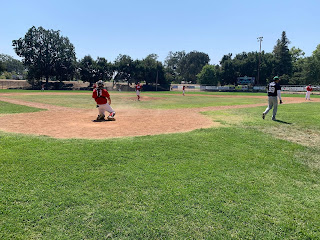 |
| Me Catching for the Outlaws on the field I grew up on |
In 2021, I was still our team's primary shortstop. But as the season went on, because of injuries or absences, I was often called upon to be more of a utility player, plugging positional needs as needed. I shifted to 3rd for some games. Pitched in others. And got to don the gear fairly often.
I'm not a pro. That's for sure. I have a long way to go to consider myself a good adult league player. But I keep working at it. My strength at the position is being able to hold up physically to the wear and tear of the position. My weakness is not having a cannon for an arm, often leading to rushed, inaccurate throws. But I work on my flaws and try to improve upon my strengths. Most importantly, I have a lot of fun back there.
In Arizona, I caught 1 game for the Outlaws at the NABA World Series in early October. In late October, I returned to Arizona for the MSBL World Series and caught 3 games for Team Oklahoma. I had the time of my life.
I'm a utility guy who is primarily a shortstop. But, by far, my favorite place to play is the 2 spot.
A lot is asked of the one behind the mask
The catcher is the one player on the field not wearing a hat. But, figuratively, he's asked to wear many at the same time.
In addition to squatting behind the plate for hours per game, being a mind reader, therapist, coach, salesman and field boss are all jobs catchers take on from the field. They have to be analytical, creative and practical.
The Physical
 |
| Bradley Wilson practicing blocking drills |
Get down in a squat position. Go ahead. Sit on your heals. You there? Good. Now sit there for ten minutes. You can move around a bit. Jump up quickly every so often. Slam your knees into the ground here and there. Did you make it ten minutes? Good. Now you can take a 10 minute break. But you've got to do that eight more times in the next couple hours.
Now imagine doing that wearing a helmet, mask, chest protector and shin guards. Don't forget the cup that needs readjusting everytime you stand up. You get to do this with a ball being thrown right at you, over and over. Most will be catchable. Many will be in the dirt and you have to use your body to stop it from getting by.
Occasionally, you'll have to jump up and take off running if a ball gets by you. Or to run down the first base line to back up an infield throw.
Pop ups are fun. The ball is moving away from you instead of toward you. You have to figure out where it is since it popped out of your line of sight. While you run to where it should come down, you have to hope you don't run into the backstop or step on a bat, then try to catch the ball with a mitt not made for fly balls.
 |
| Rob Streib throwing back to the pitcher |
You throw. It's their job to get there.
Being able to have a quick transition from glove to hand is important. So is a strong, accurate throw. Even if it's just back to the pitcher.
Catching is by far the most physically demanding position on the field. But in reality, that's the easy part.
Pitch Calling
A catcher often has to work with different pitchers throughout the game. As the signal caller, the catcher needs to know what pitches the hurler has available and how well they execute each of them. Over time, they get acquainted with everything the pitcher throws and will use that familiarity to get the best results for the team. Sometimes, he may be catching someone new and needs to be a quick study.
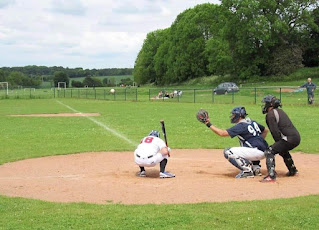 |
| Csaba Szilagyi of the London Mustangs keeping the batter off balance with his pitch calls |
What ever the call, they are making the request with a specific intent, and analyzing all information at their disposal to make decisions on the fly. As with most things, it requires practice.
Getting the most from their Battery Partner and Teammates
Every ball player needs focus on the field. The physical aspects of the game are tough, but the mental part of baseball can overcome or hamper a player's efforts on the field. This is especially true when hitting and pitching.
With the batter, the catcher and pitcher work together to get the hitter off balance. They want them expecting one thing and seeing another. The more they get the batter thinking about, the less likely they are to guess right.
To achieve this, though, the pitcher needs to be performing optimally. Throwing pitches with proper movement and locating them in the right spot. Like the batter, if too much is going on in their mind, performance can suffer. There's a trust that needs to be established between the hurler and receiver.
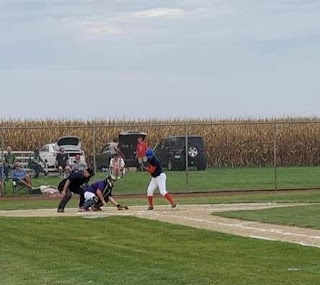 |
| Ryan Kirkpatrick working behind the plate for the Demons at the Rippey Ruckus |
In the game, in addition to other responsibilities, they are the first gauge on the pitcher's performance. They need to be able to tell if something is off and diagnose it quickly. Determine if an issue is mechanical or mental.
The more a catcher works with an individual pitcher, the better they can read the performance. The pitcher's personality makes a difference in how a catcher addresses the issues they see. Sometimes it's best to talk to them between innings. Sometimes it's better to relay what you see to a coach and let them respond. Still, a mid inning mound visit is often required.
 |
| Csaba flashing his leather |
Sometimes, it's simply so the catcher can get a chance to stretch out his legs. Guilty!
In some systems, the catcher also acts as the field boss, lining up the defense for each hitter or situation. Reminding their teammates of the amount of outs or where the play will likely be at. On throws to home from the outfield, they lineup the cut off man and determine whether a cut should be made at home.
And, even though the rules have changed a lot to prevent it, catchers have to be ready to get bulldozed if a runner is coming home on a close play.
The Umpire's Friend (or enemy)
 |
| Ryan O'Meara preparing to take his spot behind the plate for the Caribs |
But for nine innings the catcher has the field judge hanging over their shoulder. And there are ways to get better calls.
The umpire is supposed to be neutral. And they do their best to be. But, they are human, and every catcher should use this to their teams advantage. You can bet the opposing catcher probably is.
First off, introduce yourself and shake their hand. You're going to spend the next few hours together.. get acquainted. If you have any questions, like the amount of warm up pitches between innings or how you should ask for an appeal on a check swing, do it first thing. When you go back to the dugout after an inning, ask if they need water, that gear gets hot.
In general, just be a decent person. They appreciate that.
Framing is an art. Trying to pull a pitch from a foot outside to the middle of the plate won't get you strikes. But bringing it from six inches outside to the corner often will, if don't properly.
The best way to explain framing is this...put the umpire in the best position to give you the strike call.
It may be from pulling the glove up or in slightly. It may be where in the mitt you catch the ball (pocket or heal), or it may be in what orientation of the glove you catch it. Regardless, it's to make it look as though it's caught in a plausible spot where the ball could have crossed the plate.
Play to the umpire's sense of fairness. This one has worked for me more often than not. You catch a ball near a corner of the zone and hold it. Its close enough that you think it should be a strike. If he calls it a ball, tell him "good call". Not condescending or sarcastically. Say it like you mean it.
Now call the same pitch in the same location. Assuming it's executed the same as the last one, the batter probably won't swing, but you will usually get it called for a strike. I can't explain why it works, but it does. I believe it's because umpires are trying to do a good job and so they question and critique themselves internally on close calls.
If you ever have to question an umpire's call, do it respectfully. I can't emphasize this enough. It will work in your favor. Besides, the point of playing baseball is to have fun. Smile.
Being an Adult league Catcher
Every level of catching has its challenges and rewards. At the youth level, it's about learning. At the high school and college level it's about fine tuning and standing out. At the pro level, it's about continuing to earn a spot and paycheck.
Then there's the adult league. More than anything, it's about staying healthy. But this level may be the most fun of all.
 |
| Bill Washenko (NY) tagging John Moore (MN) |
On Monday you have to go to work. But on Sunday, you are out there behind the dish, sacrificing your body for the team. And you do it because you love it. You love catching. You love the game within the game. You love being involved on every pitch.
Those bruises don't hurt as much the next day after a win. And even in a loss, you know you gave every bit of yourself for your teammates.
You may be catching a pitcher throwing 85 mph one minute and the next, you are blocking balls for a junk baller that might hit 50 on a good day with the wind to his back.
 |
| Bob Sarvey (MN) stretching out to make the tag to complete a triple play! |
You love being able to see everything happening on the field from your front row seat behind the plate. And you enjoy having a hand in setting the action in motion.
Every runner thrown out is a memory. Every strike out a victory. And every game is a chance to do your favorite activity.
I'm in awe of the guys still suiting up in their retirement years. It's only a love of the game that can fuel that commitment. Catching is not easy on the body. To be doing it at 70 is an accomplishment in and of itself.
Even at 40, as a part time catcher it takes a toll. I've woken up with bruises I didn't remember getting. Knots on my forearms from blocking breaking balls. Sore muscles from foul tips. Having jelly legs stepping into the batters box late in the game.
In Arizona, I caught three days in a row for the first time. It gave me new respect for those that do that regularly, no matter the level they play at.
But, man, it is fun. It is my favorite spot to be on the field. And I hope I keep getting the chance to wear the mask for years to come.
 |
| Randy Kirkpatrick dressing for work |
Play ball
⚾️⚾️⚾️
I hope you enjoyed the read. If you have a catcher that you appreciate, give them a shout out in the comments and share so others can get a taste of the catcher's life.
Follow The Middle Age Amateur Ball Player for more stories that touch on the side of baseball you don't always see or hear.

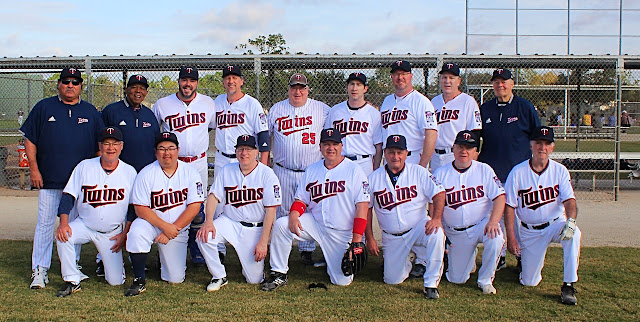


My dawg Steve Bonnain FTW!! Did a great job behind the plate in AZ for the Houston Cyclones!!
ReplyDeleteLove this! I've been itching to get back into an adult league at 40 and wondered whether I could catch again after almost a decade without playing. You're inspiring me to train up and give it a shot!
ReplyDelete